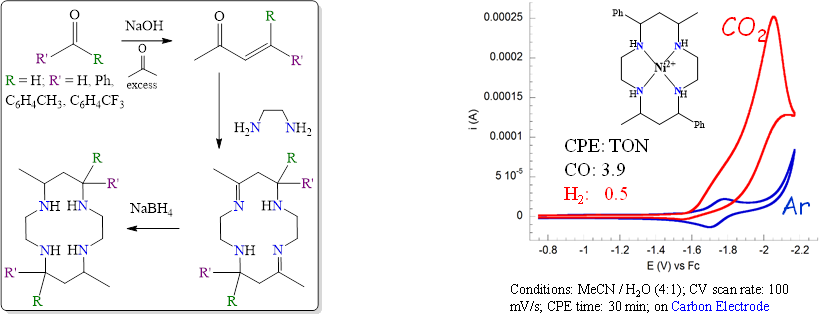Area III. Carbon Dioxide Fixation
Regenerating carbon fuels from carbon dioxide using solar energy has been a long standing and yet unsolved challenge that holds promise for both greenhouse gas reduction and as an alternative energy source. Our primary interest lies in developing efficient electrochemical catalysts based on new NiII(cyclamʹ) complexes, where cyclamʹ is C-substituted derivatives of cyclam. A proper C-substitution may steer the cyclam ring to a conformation favoring carbon dioxide binding and hence improved catalytic efficiency. Recently we reported that aryl substituents can be introduced at the 7,12-positions of cyclam and the resultant NiII(cyclamʹ) with Ar = Ph (NiII(MPC)) exhibits significantly improved TON and selectivity for CO over H2 compared to the parent NiII(cyclam). Besides optimizing NiII(cyclamʹ) catalysts via varying the C-substituent, we are pursuing two new directions: (i) improving chemical selectivity through the introduction of remote functional groups such as ammonium and phenol and (ii) incorporating optimized NiII(cyclamʹ) into photoelectrochemical cells.
Selected References:
General review: Appel, et al. Chem. Rev. 2013, 113, 6621-6658; "Frontiers, Opportunities, and Challenges in Biochemical and Chemical Catalysis of CO2 Fixation"; http://dx.doi.org/10.1021/cr300463y.
Recent publication: Cook, T. D.; Tyler, S. F.; McGuire, C. M.; Zeller, M.; Fanwick, P. E.; Evans, D. H.; Peters, D. G.; Ren, T. ACS Omega 2017, 2, 3966-3976; "Nickel Complexes of C-Substituted Cyclams and Their Activity for CO2 and H+ Reduction"; http://dx.doi.org/10.1021/acsomega.7b00714.

